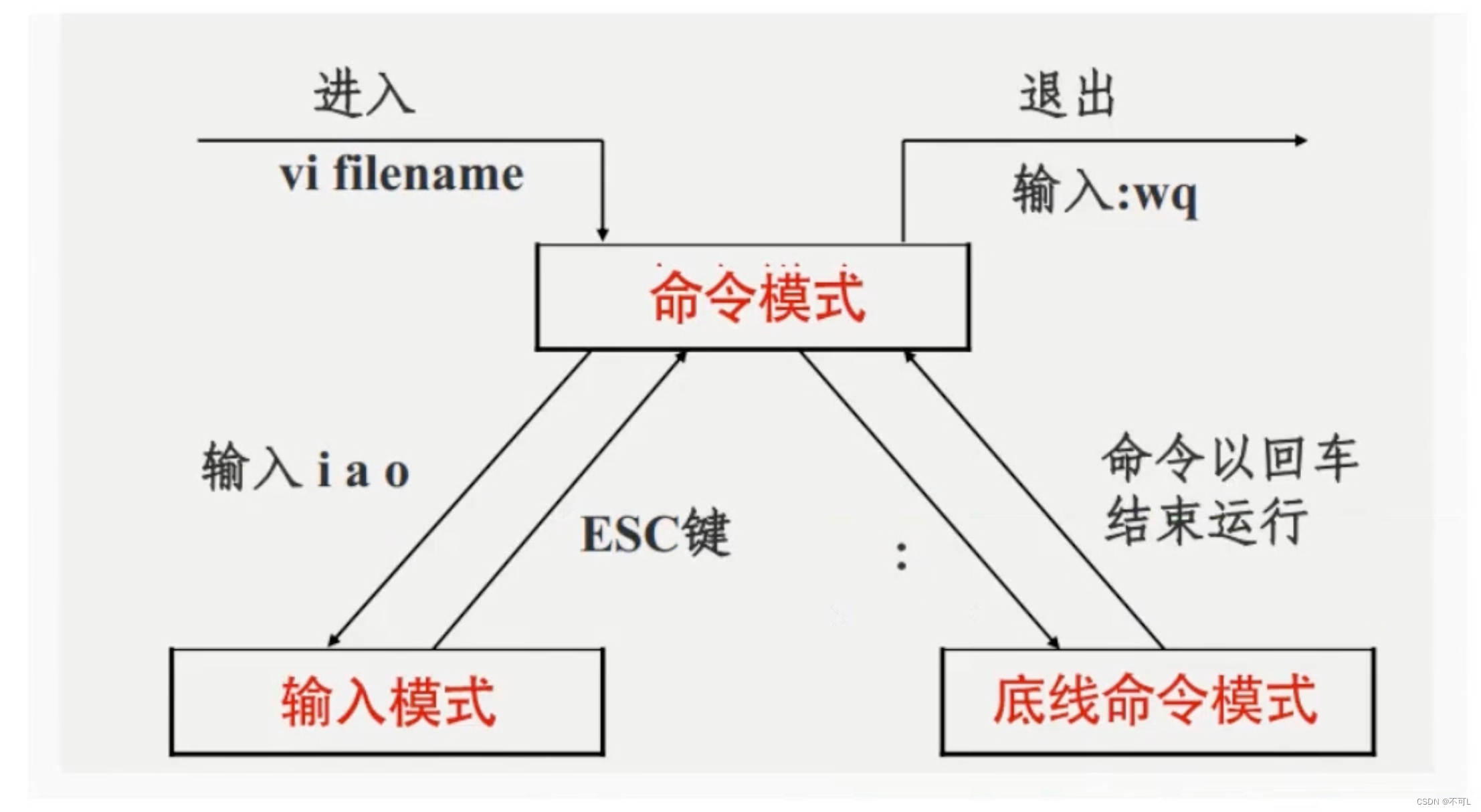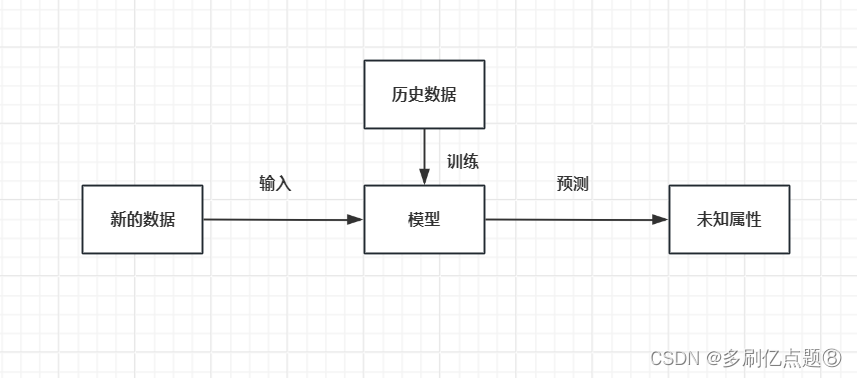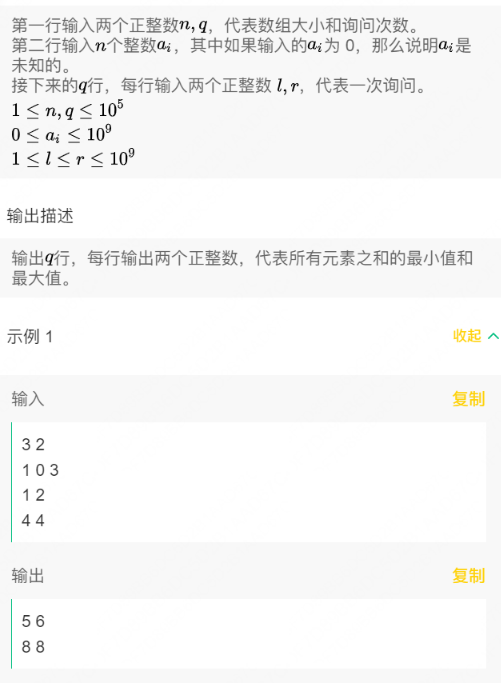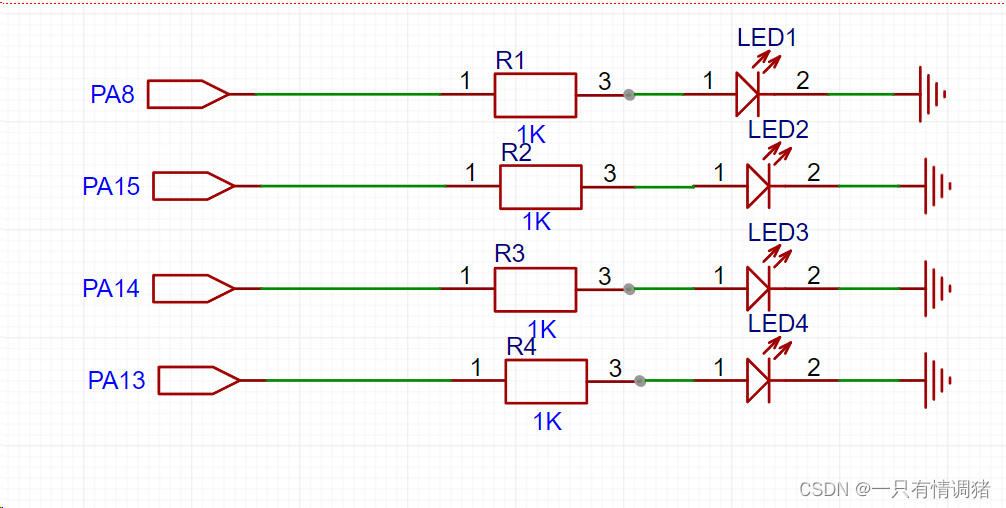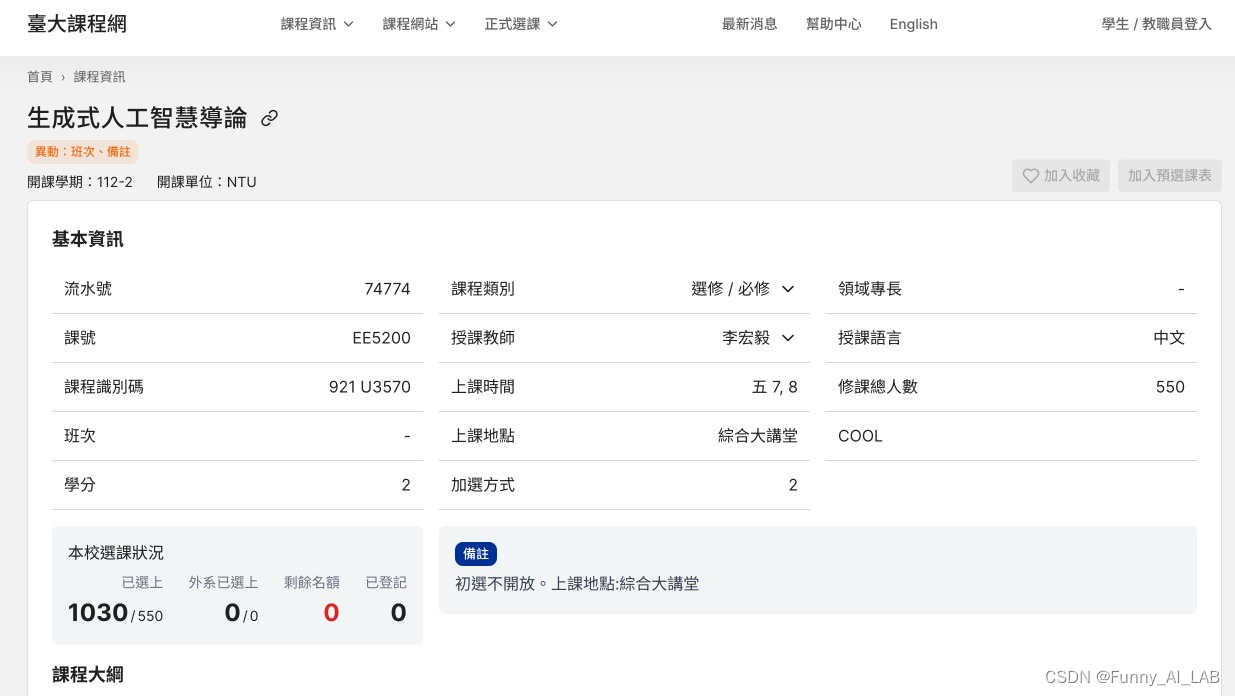素数之积
题目描述
RSA加密算法在网络安全世界中无处不在,它利用了极大整数因数分解的困难度,数据越大,安全系数越高,给定一个32位正整数,请对其进行因数分解,找出是哪两个素数的乘积。
输入描述
一个正整数num,0 < num <= 2147483647
输出描述
如果成功找到,以单个空格分割,从小到大输出两个素数,分解失败,请输出-1, -1
用例
输入15输出3 5输入27输出-1 -1
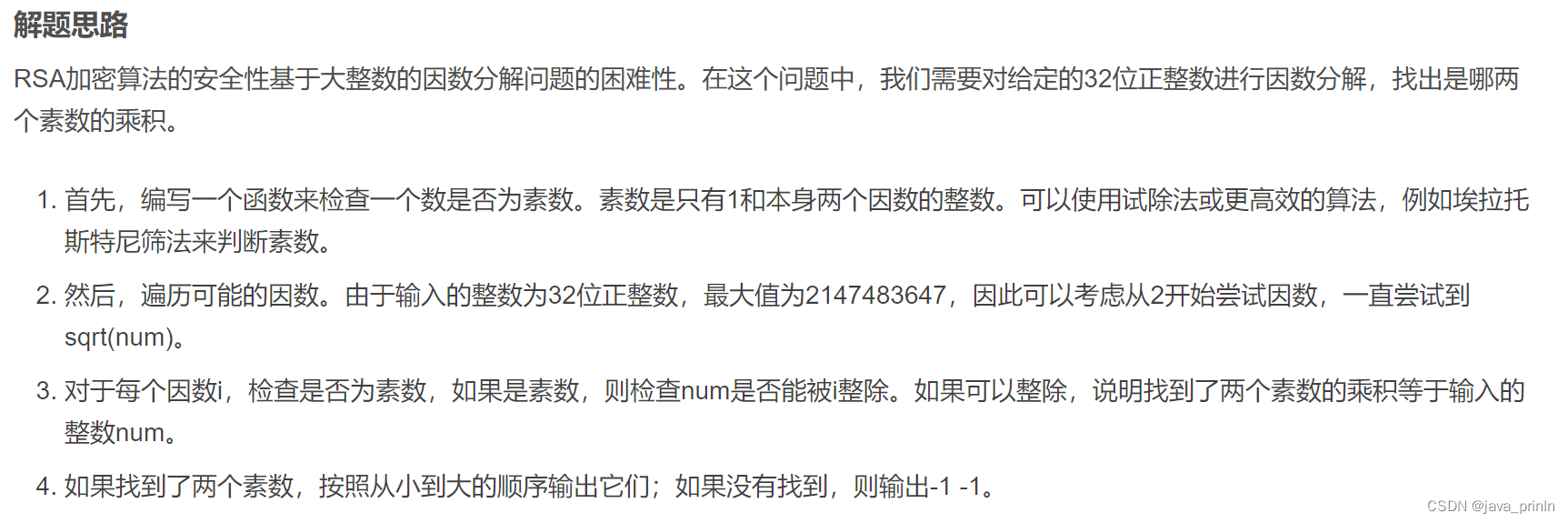
import math
def is_prime(num):
if num < 2:
return False
for i in range(2, int(math.sqrt(num)) + 1):
if num % i == 0:
return False
return True
def factorization(num):
for i in range(2, int(math.sqrt(num)) + 1):
if num % i == 0 and is_prime(i):
j = num // i
if is_prime(j):
return i, j
return -1, -1
# 输入
num = int(input("请输入一个正整数num: "))
# 因数分解
result = factorization(num)
# 输出结果
print(result[0], result[1])

最大坐标值
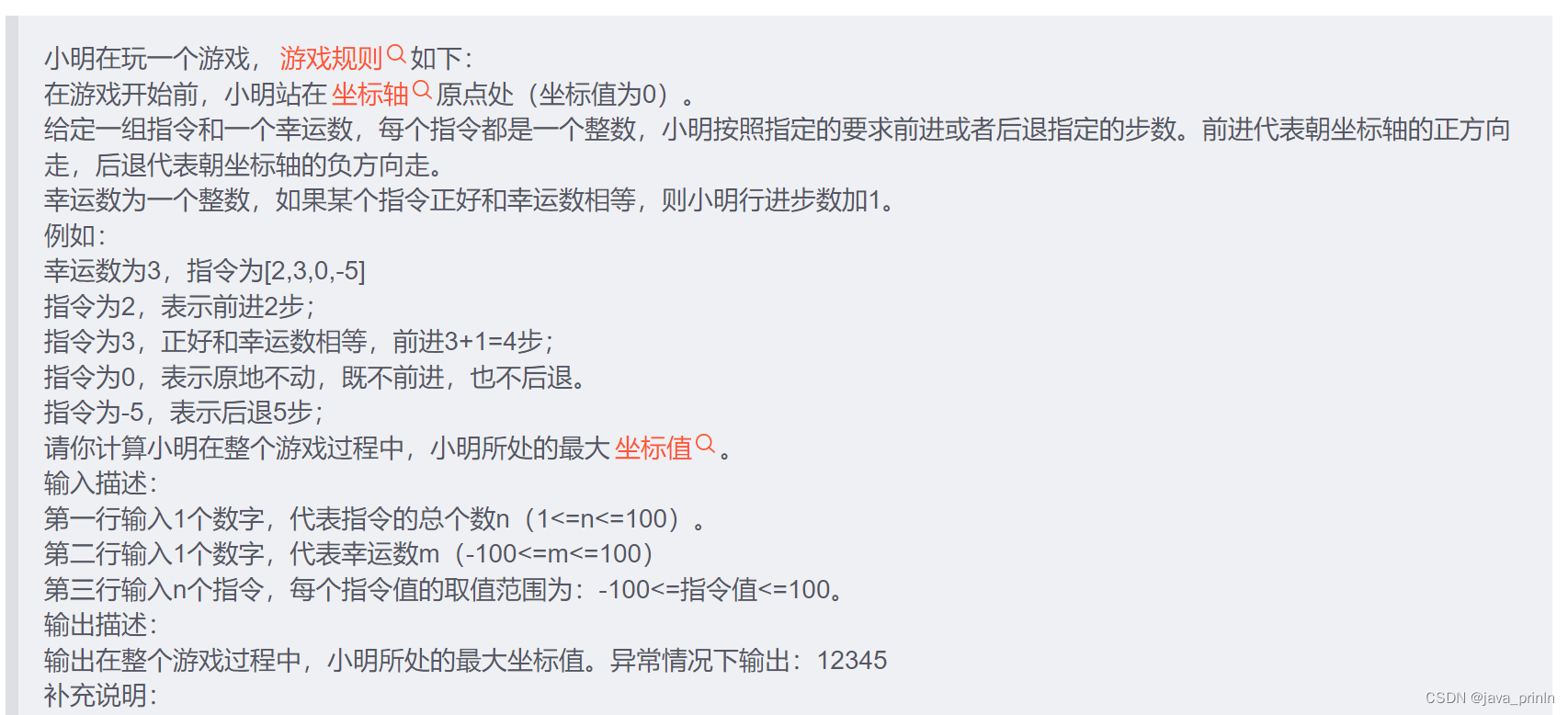
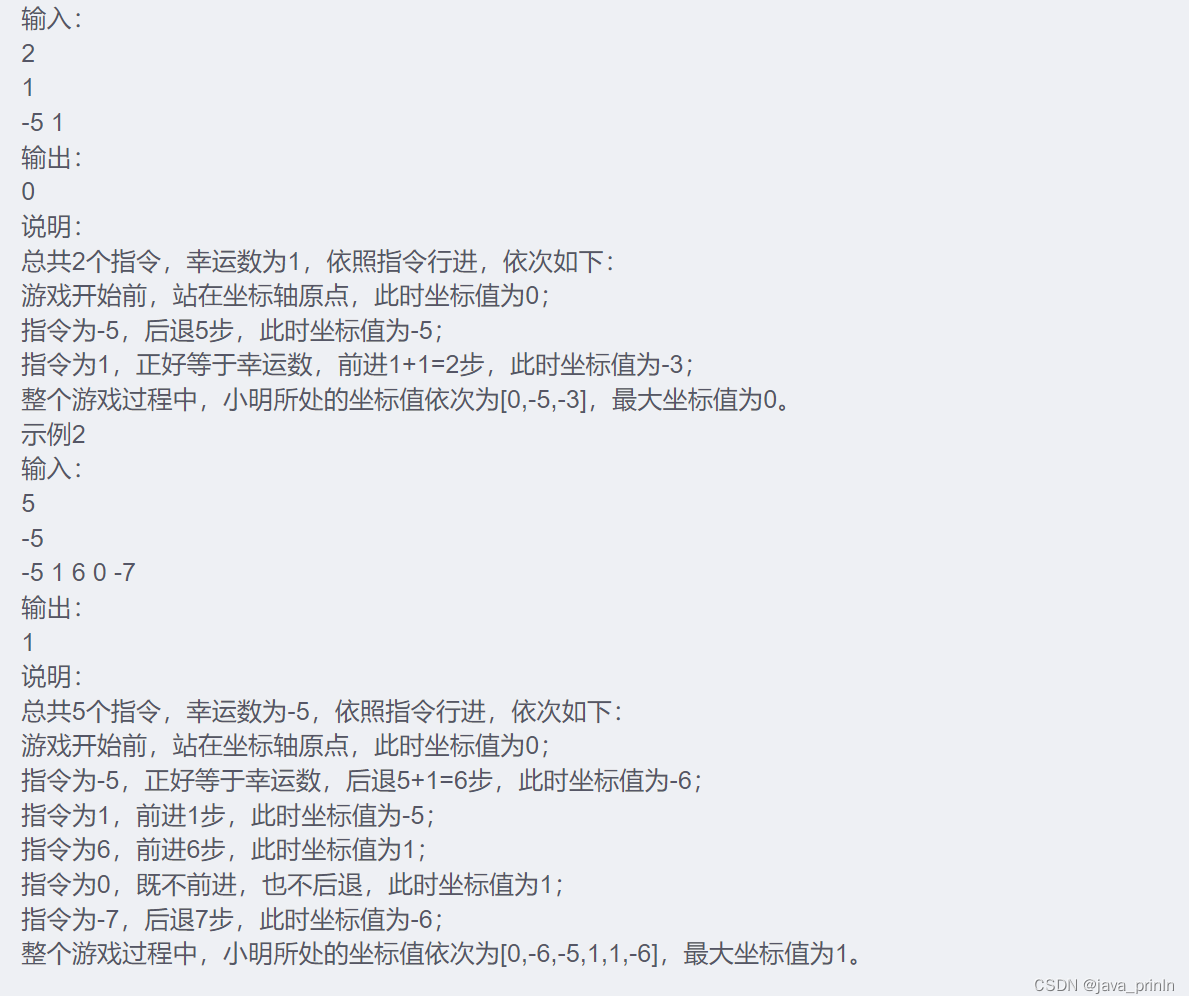
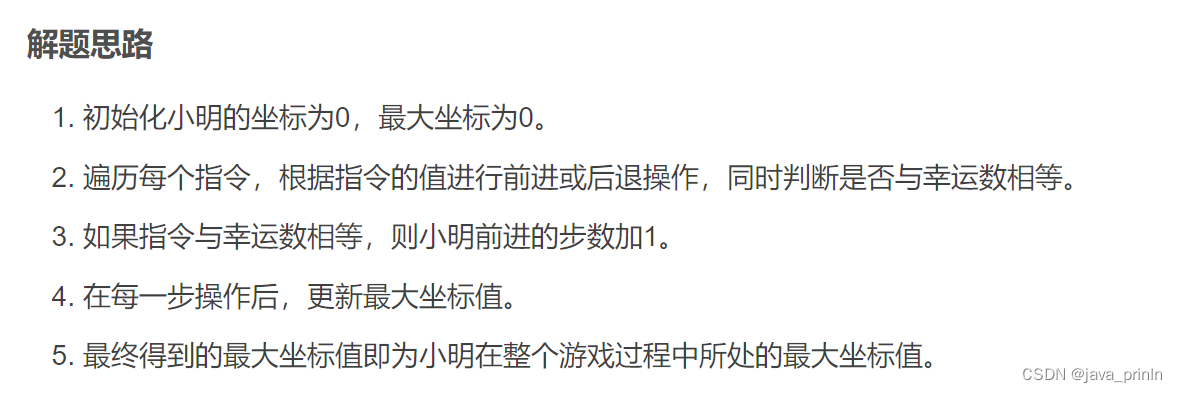
def calculate_max_coordinate(n, lucky_number, instructions):
current_coordinate = 0
max_coordinate = 0
for instruction in instructions:
if instruction == lucky_number:
current_coordinate += instruction + 1
else:
current_coordinate += instruction
max_coordinate = max(max_coordinate, current_coordinate)
return max_coordinate
if __name__ == "__main__":
try:
# 输入指令总个数
n = int(input().strip())
# 输入幸运数
lucky_number = int(input().strip())
# 输入指令列表
instructions = list(map(int, input().strip().split()))
# 计算最大坐标值
result = calculate_max_coordinate(n, lucky_number, instructions)
# 输出最大坐标值
print(result)
except Exception as e:
# 异常情况下输出:12345
print(12345)
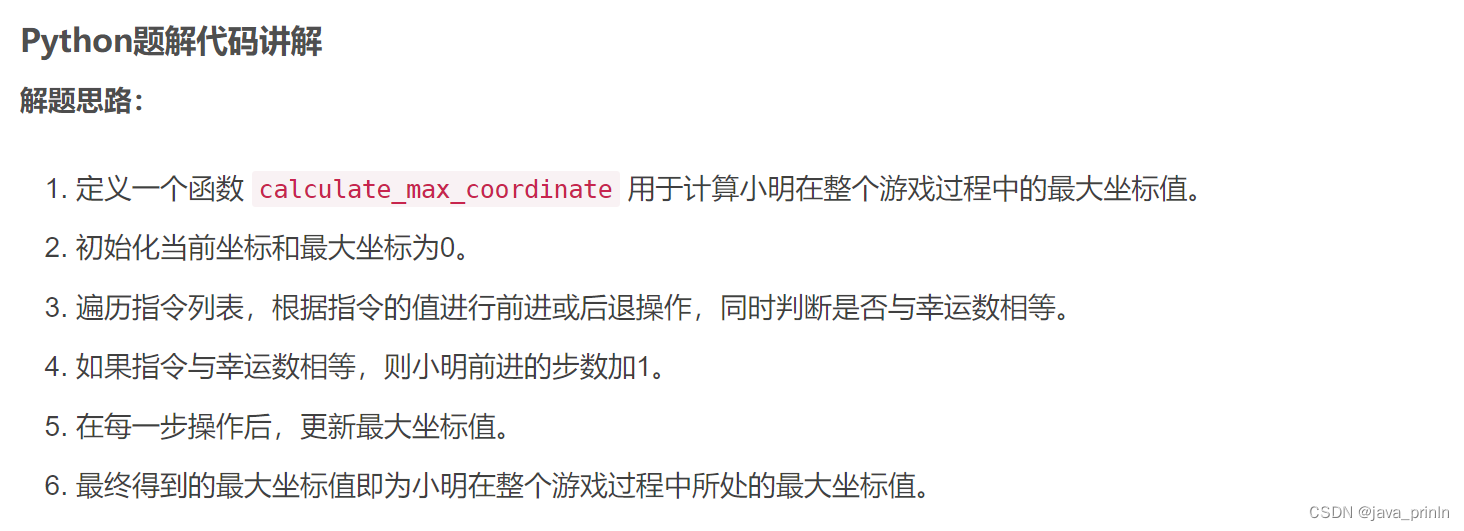
CPU算力分配
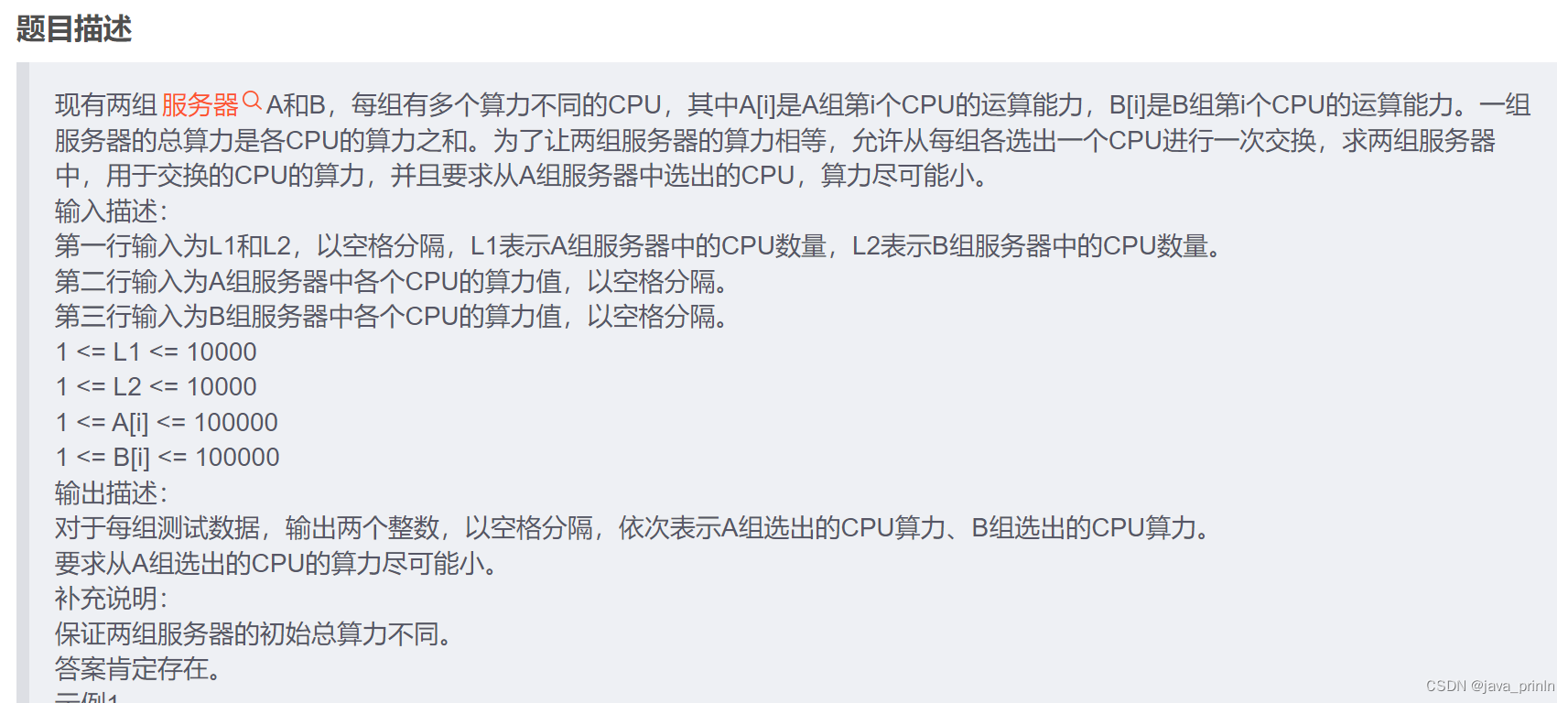


L = input().split()
L1, L2 = int(L[0]), int(L[1])
A = list(map(int, input().split()))
B = list(map(int, input().split()))
suma = sum(A)
sumb = sum(B)
ava = int((suma + sumb) / 2)
value = abs(ava - sum(A))
A.sort()
B.sort()
if suma > sumb:
for item in A:
if (item - value) in B:
print(item, item - value)
break
else:
for item in A:
if (value + item) in B:
print(item, value + item)
break
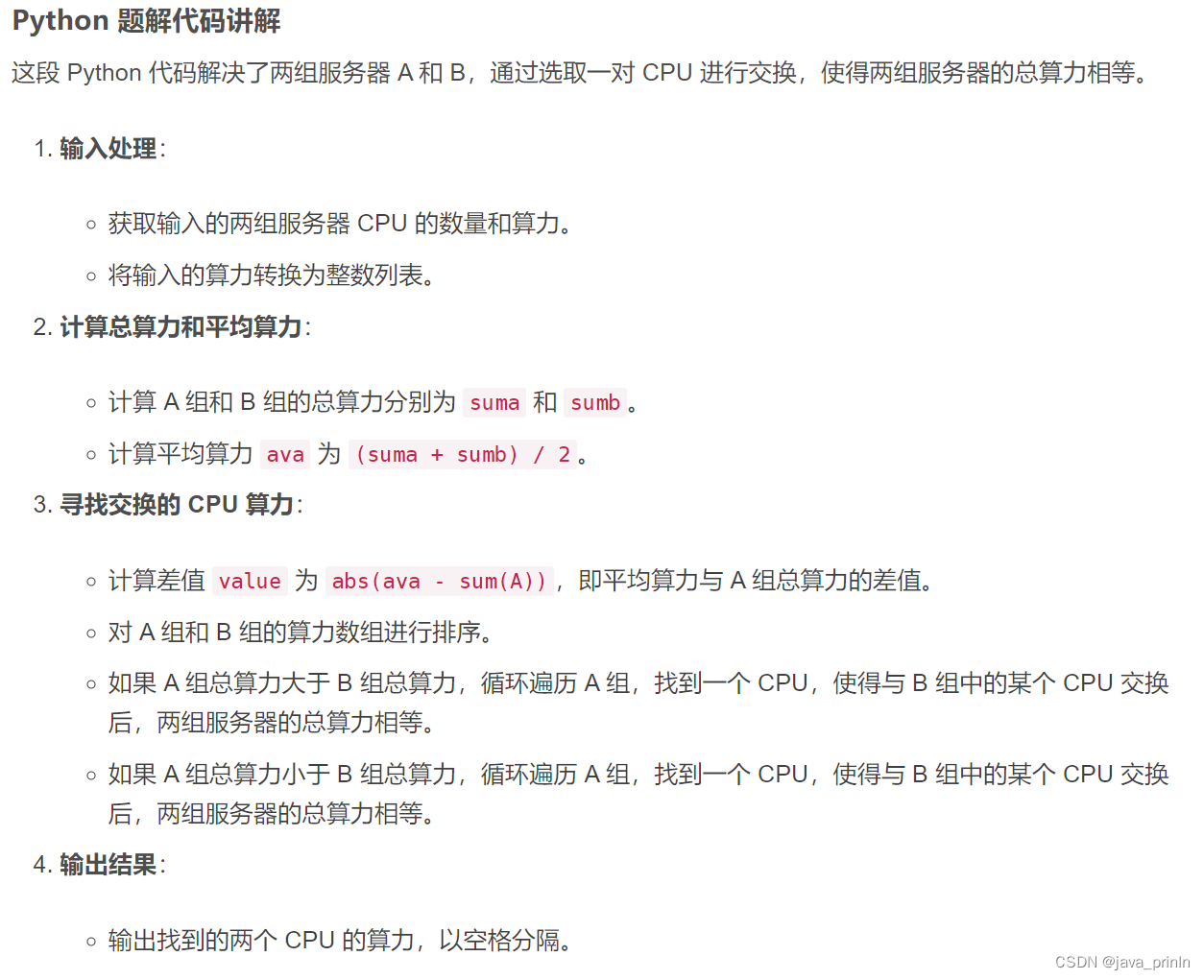
寻找最富裕的小家庭
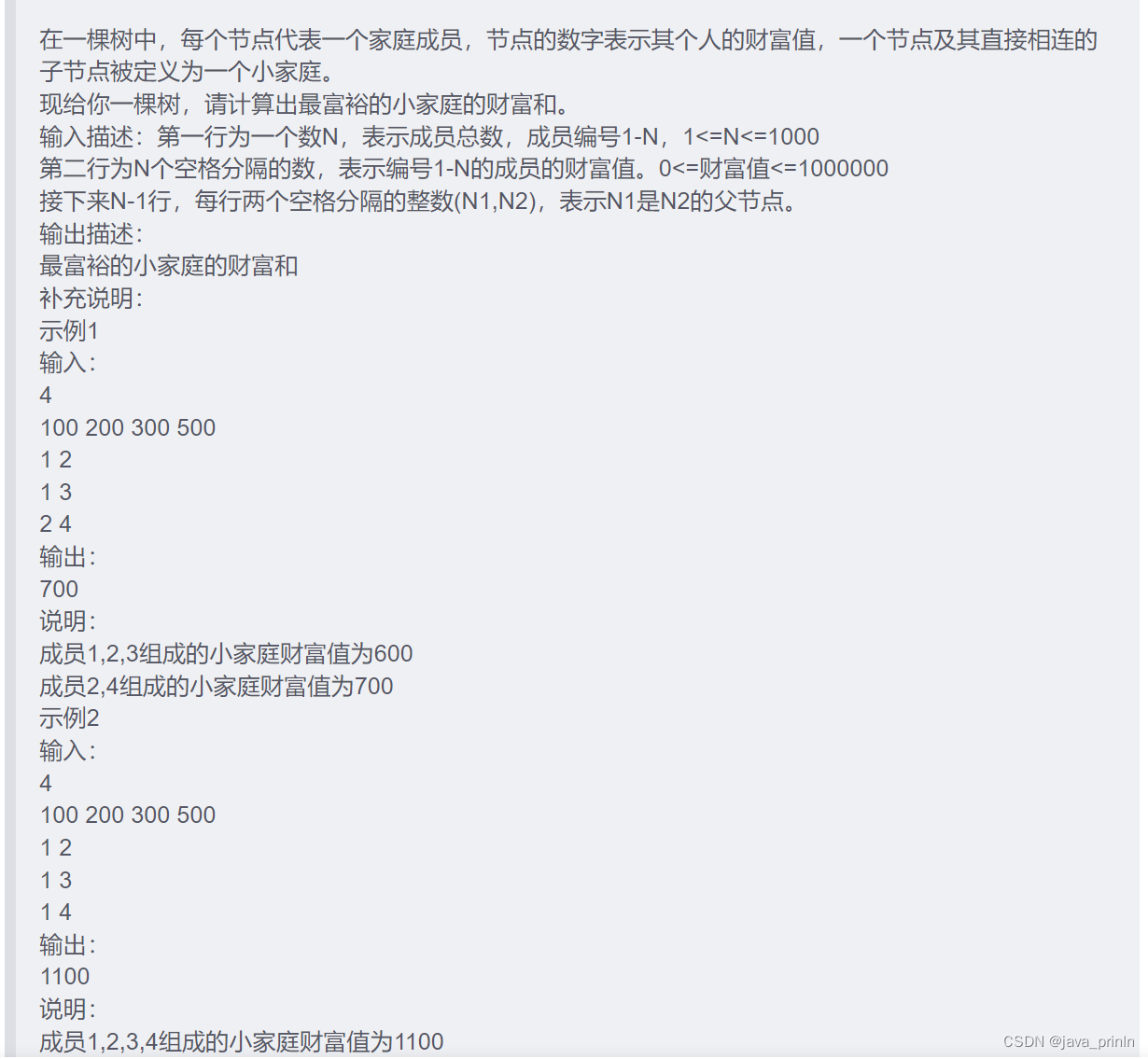
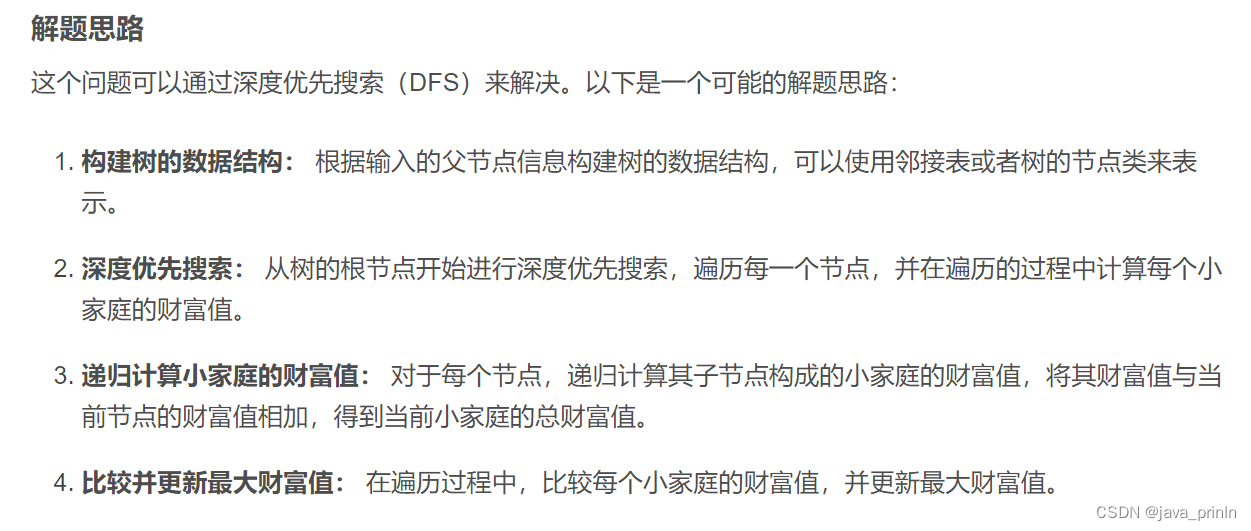
# Python题解代码
class TreeNode:
def __init__(self, value):
self.value = value
self.children = []
def dfs(node, max_wealth):
current_wealth = node.value
for child in node.children:
current_wealth += dfs(child, max_wealth)
max_wealth[0] = max(max_wealth[0], current_wealth)
return current_wealth
def main():
N = int(input())
wealth_values = list(map(int, input().split()))
nodes = [TreeNode(value) for value in wealth_values]
for _ in range(N - 1):
parent, child = map(int, input().split())
nodes[parent - 1].children.append(nodes[child - 1])
max_wealth = [0]
dfs(nodes[0], max_wealth)
print(max_wealth[0])
if __name__ == "__main__":
main()
查找接口成功率最优时间段


def main():
minAverageLost = int(input())
nums = input().split(" ")
nums = [int(num) for num in nums]
res = []
length = 0
for i in range(len(nums)):
for j in range(i, len(nums)):
if sum(nums[i:j+1]) <= minAverageLost * (j-i+1):
if length > j-i+1:
continue
elif length == j-i+1:
res.append([i, j])
else:
res = [[i, j]]
length = j-i+1
for i in range(len(res)):
if i == len(res)-1:
print(f"{res[i][0]}-{res[i][1]}")
else:
print(f"{res[i][0]}-{res[i][1]} ")
if __name__ == "__main__":
main()
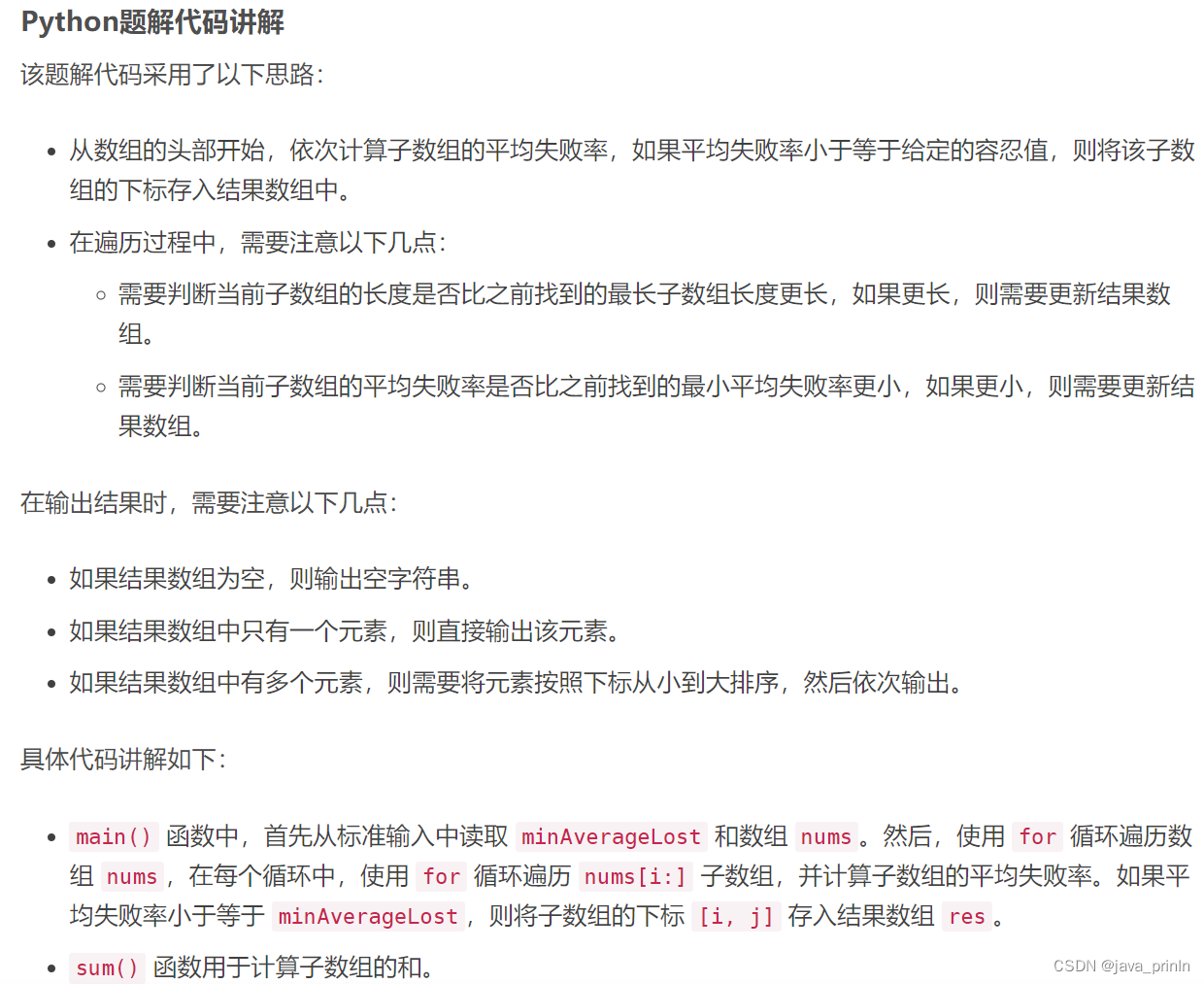
敏感字段加密


import sys
index = int(input()) # 输入命令字索引K
input = input() # 输入命令字符串S
charArray = list(input) # 将命令字符串转换为字符数组
command = "" # 当前正在解析的命令字
commandList = [] # 存储解析后的命令字列表
for i in range(len(charArray)):
ch = charArray[i]
if ch == '"' and ch in command: # 如果当前字符为双引号且命令字中已经包含了一个双引号
command += '"' # 将双引号添加到命令字中
commandList.append(command) # 将解析完毕的命令字添加到命令字列表中
command = "" # 重置命令字
elif '"' not in command and ch == '_': # 如果命令字不包含双引号且当前字符为下划线
if command: # 如果命令字不为空
commandList.append(command) # 将解析完毕的命令字添加到命令字列表中
command = "" # 重置命令字
elif i == len(charArray) - 1: # 如果已经到达字符串末尾
command += ch # 将当前字符添加到命令字中
commandList.append(command) # 将解析完毕的命令字添加到命令字列表中
command = "" # 重置命令字
else:
command += ch # 将当前字符添加到命令字中
if index < 0 or index > len(commandList) - 1: # 如果命令字索引超出范围
print("ERROR")
else:
commandList[index] = "******" # 将指定索引的命令字替换为******
result = []
for item in commandList:
result.append("_" + item) # 在命令字之前添加下划线
result = "".join(result)
result = result[1:] # 删除第一个下划线
print(result)
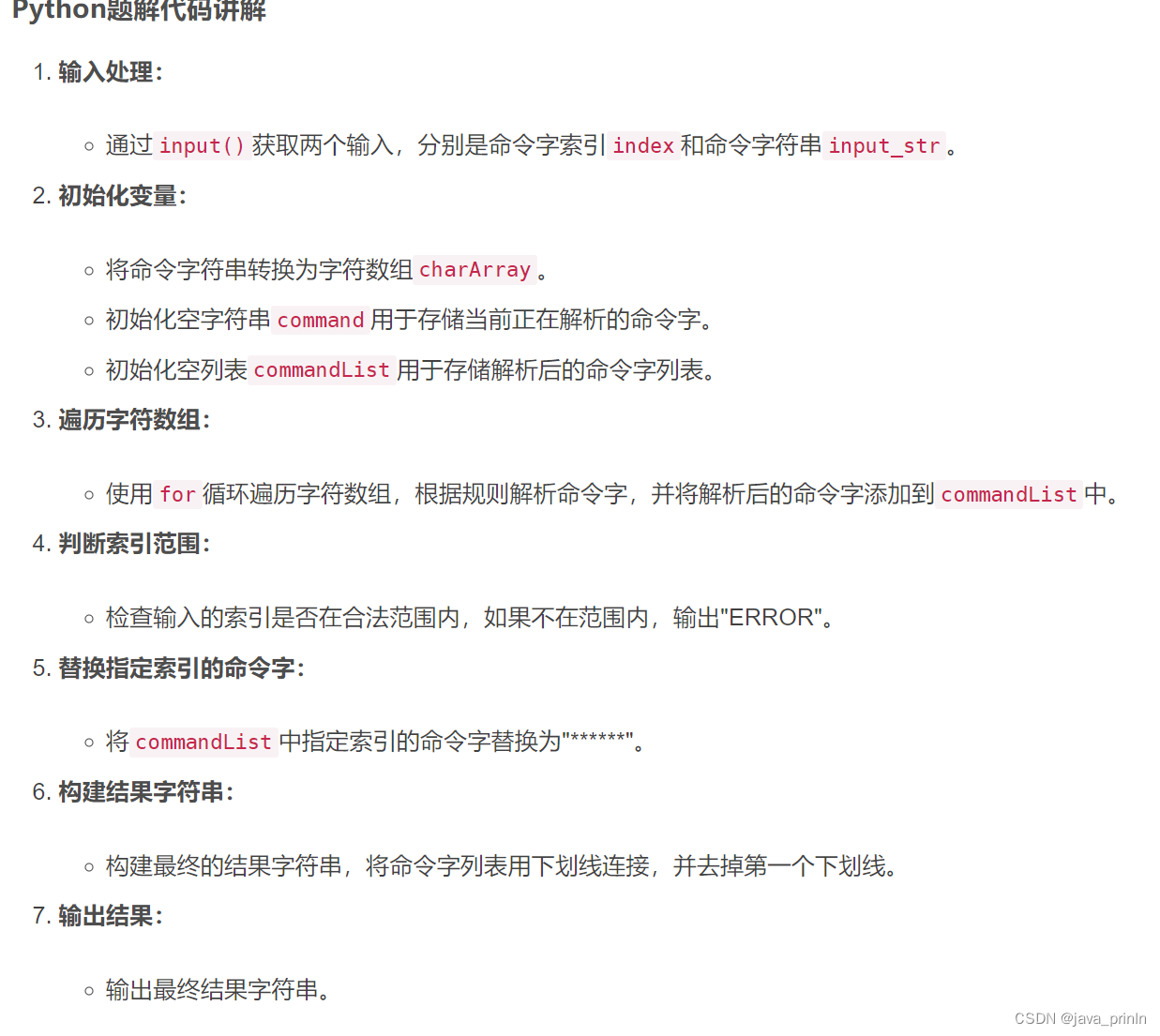
虚拟游戏理财
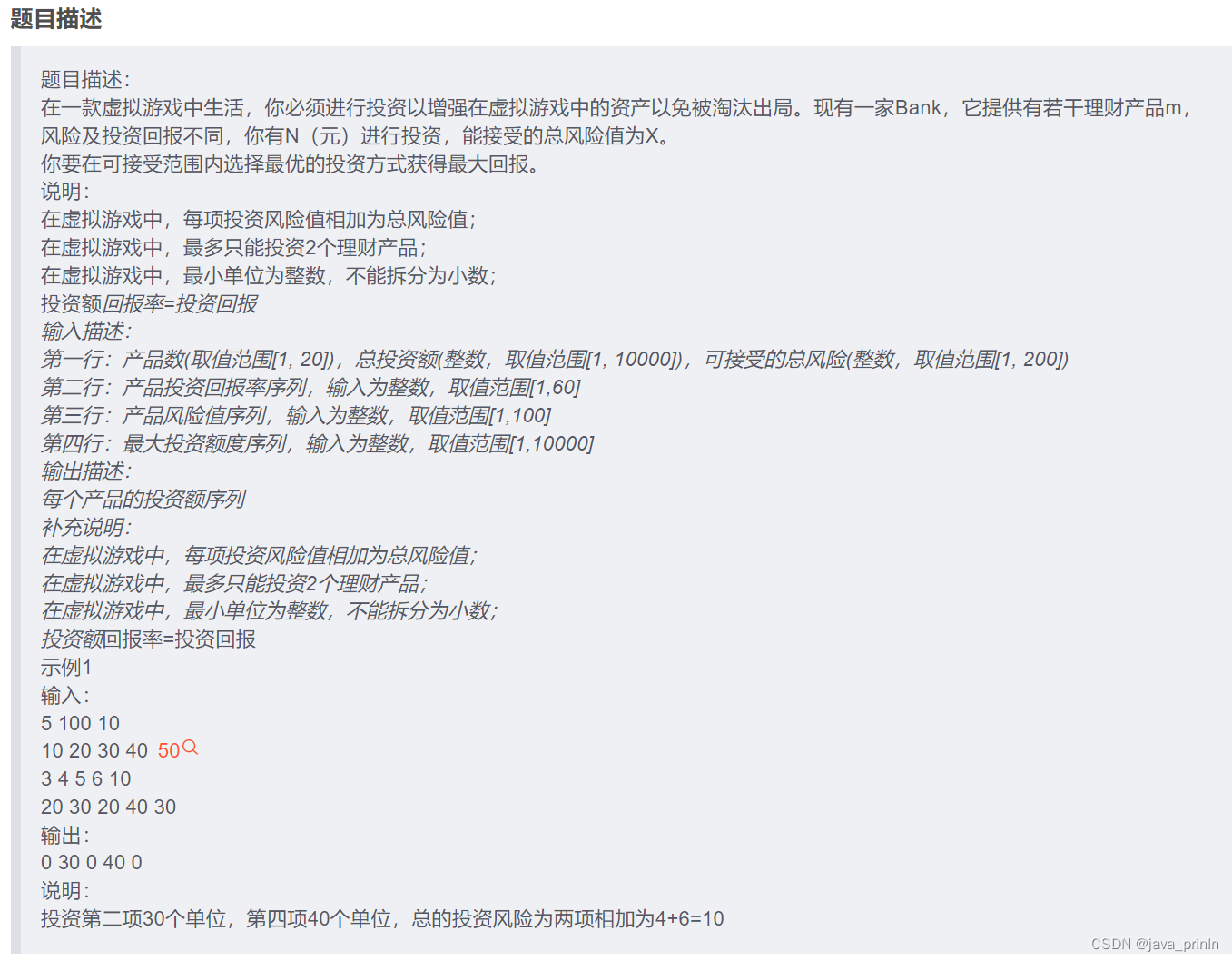
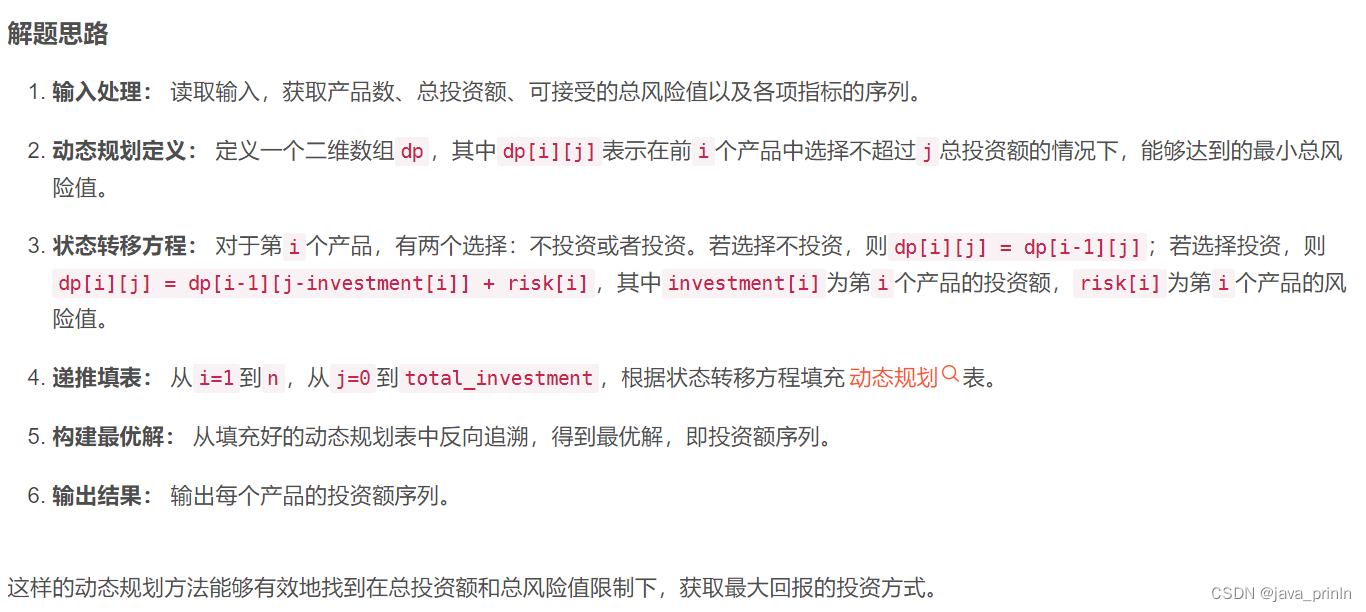
number, N, X = map(int, input().split())
return_list = list(map(int, input().split()))
risk_list = list(map(int, input().split()))
max_cost_list = list(map(int, input().split()))
return_list.append(0)
risk_list.append(0)
max_cost_list.append(0)
number += 1
max_return = 0
max_status = ["0"] * number
max_return_risk = 0
for i in range(number):
for j in range(i + 1, number):
if risk_list[i] + risk_list[j] <= X:
max_return_product_index = i if return_list[i] > return_list[j] else j
other_return_product_index = i + j - max_return_product_index
max_return_cost = min(N, max_cost_list[max_return_product_index])
other_return_cost = min(N - max_return_cost, max_cost_list[other_return_product_index])
cur_return = (
return_list[max_return_product_index] * max_return_cost
+ return_list[other_return_product_index] * other_return_cost
)
if cur_return > max_return:
max_return = cur_return
max_return_risk = risk_list[i] + risk_list[j]
max_dict = {
max_return_product_index: max_return_cost,
other_return_product_index: other_return_cost,
}
for k in range(number):
max_status[k] = str(max_dict.get(k, 0))
print(" ".join(max_status[:-1]))

IPv4地址转换成整数
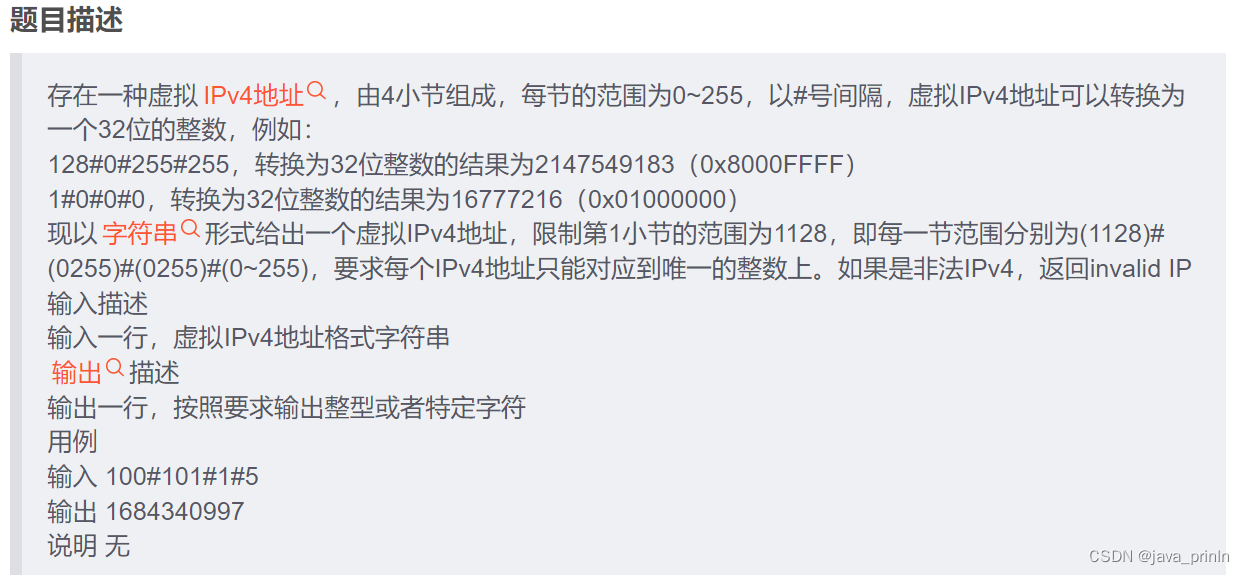
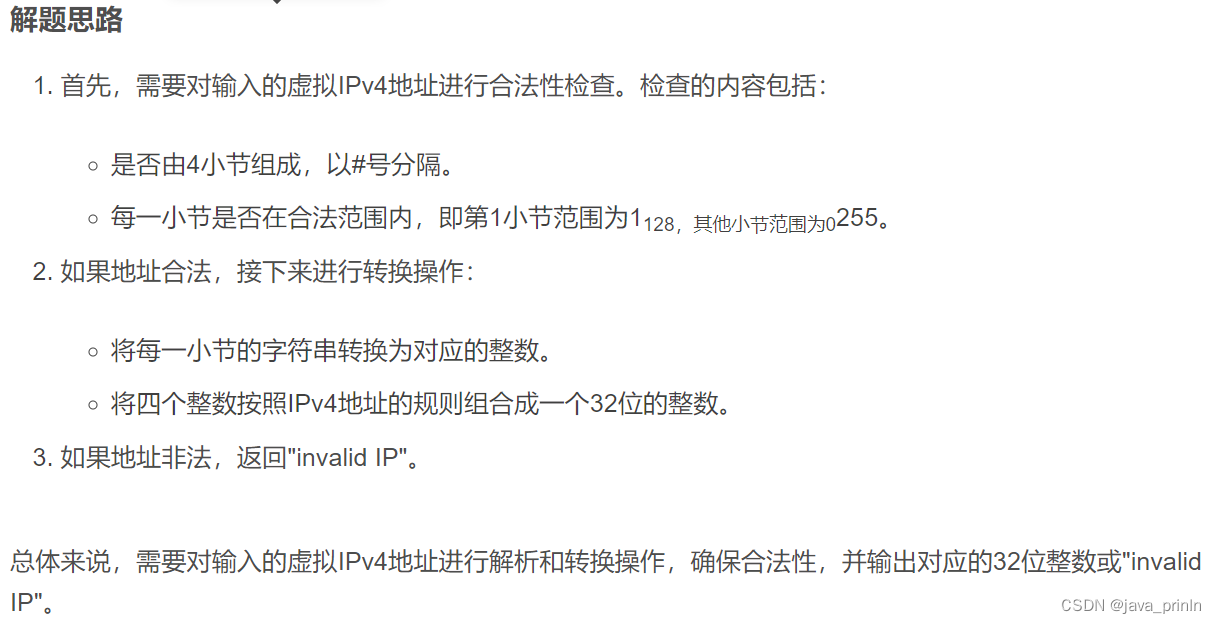
import re
input = input()
ipSections = input.split("#") # 将输入的字符串按照"#"分割成4个小节
if len(ipSections) != 4: # 如果分割后的小节数量不等于4,则说明输入的IPv4地址格式不正确
print("invalid IP") # 输出"invalid IP"表示非法IPv4地址
exit() # 程序结束
firstSection = int(ipSections[0]) # 将第一个小节转换为整数
if firstSection < 1 or firstSection > 128: # 如果第一个小节的值不在1~128的范围内,则说明输入的IPv4地址格式不正确
print("invalid IP") # 输出"invalid IP"表示非法IPv4地址
exit() # 程序结束
for i in range(1, 4): # 遍历后面的3个小节
sectionValue = int(ipSections[i]) # 将当前小节转换为整数
if sectionValue < 0 or sectionValue > 255: # 如果当前小节的值不在0~255的范围内,则说明输入的IPv4地址格式不正确
print("invalid IP") # 输出"invalid IP"表示非法IPv4地址
exit() # 程序结束
hexString = "" # 创建一个字符串变量,用于拼接转换后的十六进制字符串
for i in range(4): # 遍历4个小节
hexSection = hex(int(ipSections[i]))[2:] # 将当前小节转换为十六进制字符串
if len(hexSection) == 1: # 如果转换后的十六进制字符串只有1位,则在前面补0
hexSection = "0" + hexSection
hexString += hexSection # 将转换后的十六进制字符串添加到字符串变量中
print(int(hexString, 16)) # 将拼接后的十六进制字符串转换为整数并输出
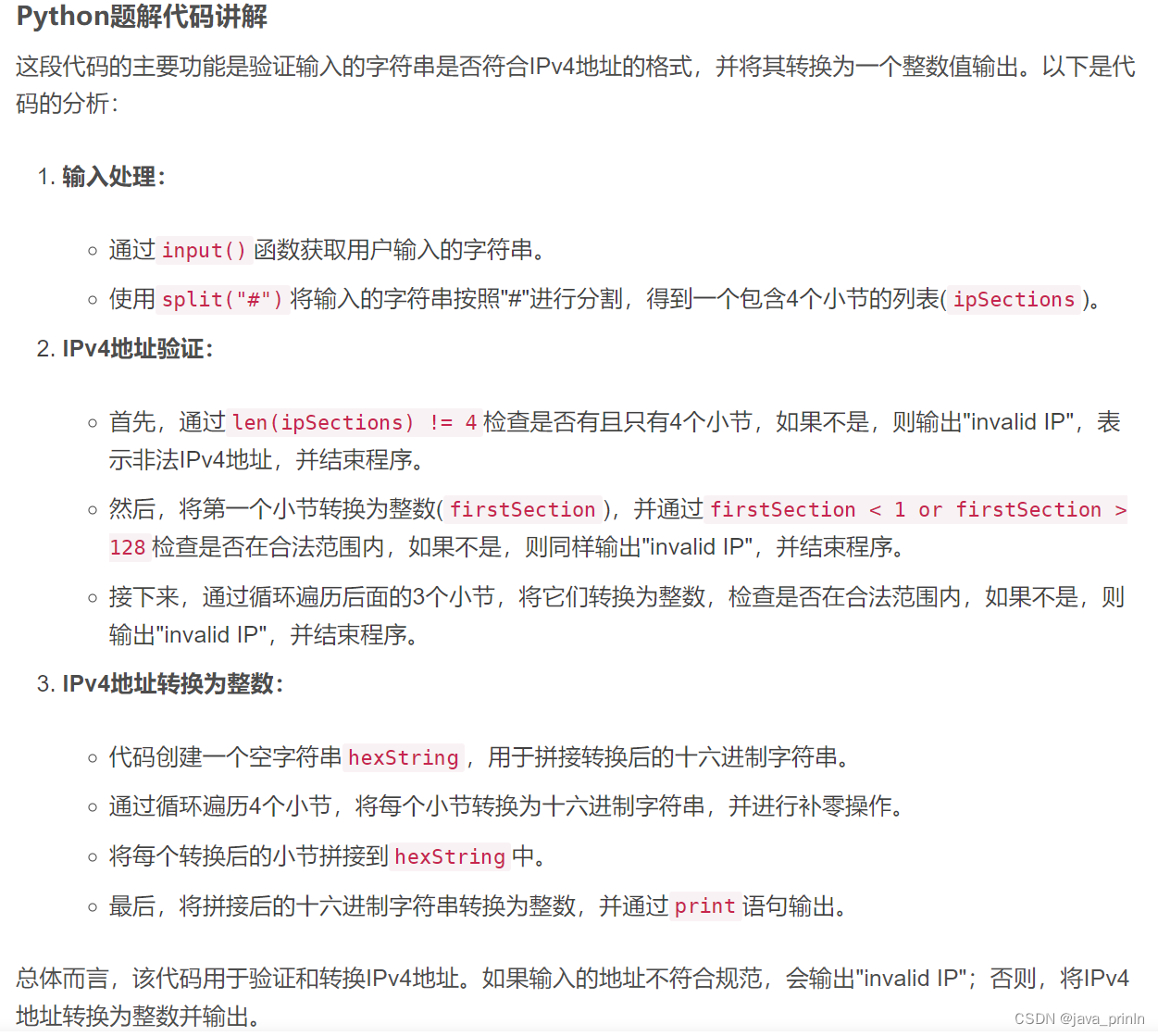
报文重排序
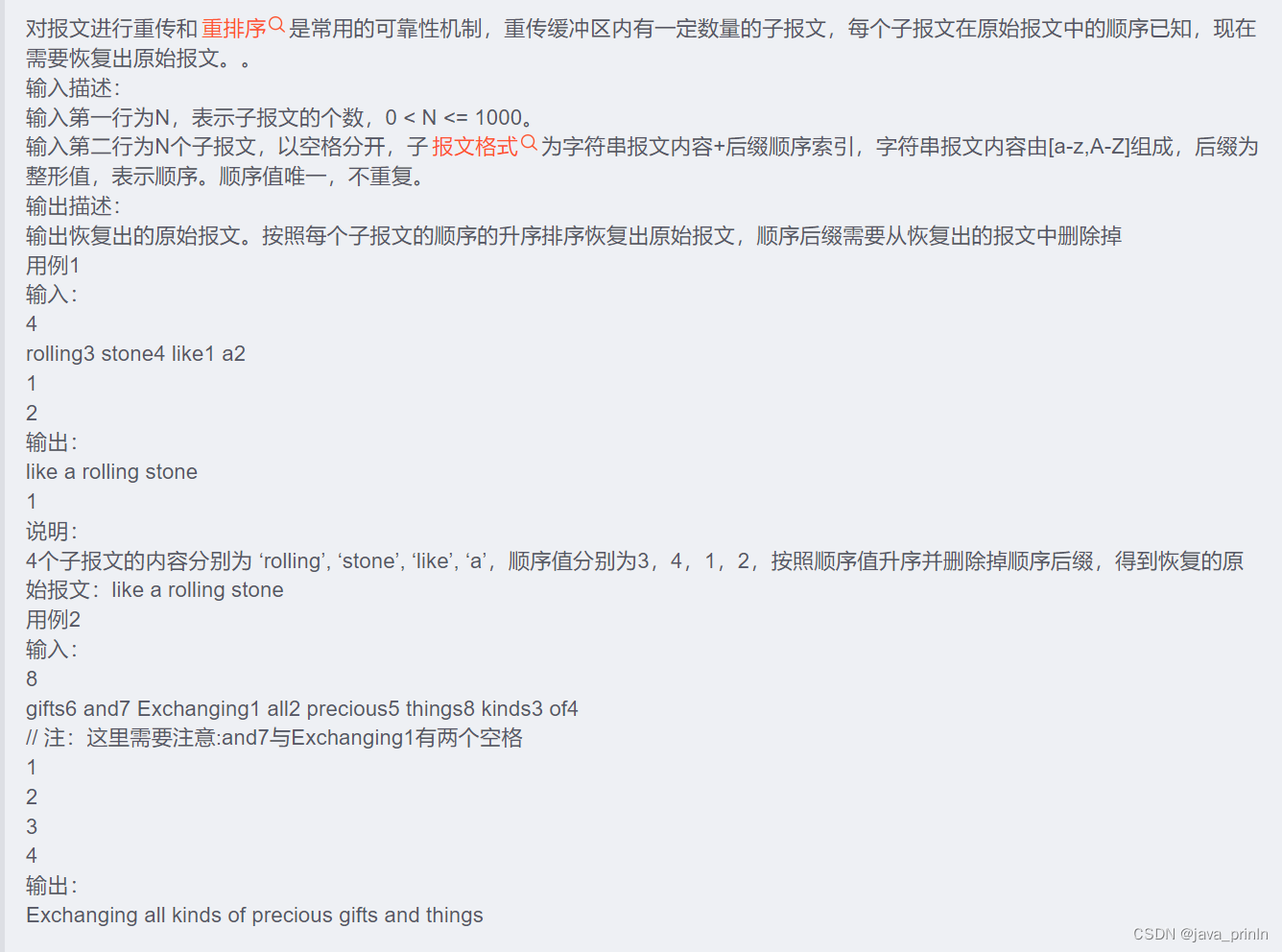
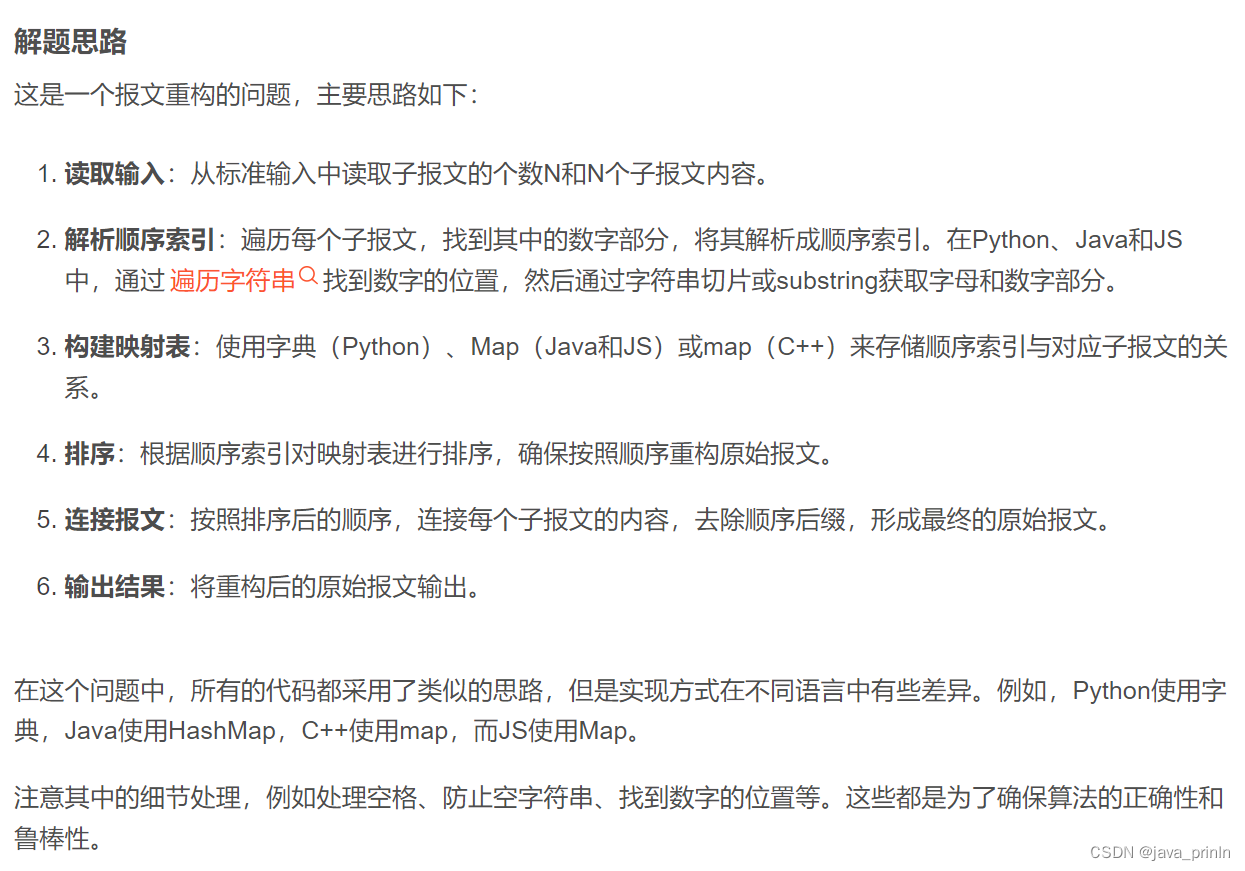
N = int(input().strip())
strings = input().strip().split()
letterMap = {}
for i in range(len(strings)):
str = strings[i]
if str == "":
continue
index = 0
for j in range(len(str)):
if str[j].isdigit():
index = j
break
letter = str[:index]
num = int(str[index:])
letterMap[num] = letter
res = ""
for i in range(1, N+1):
res += letterMap[i] + " "
print(res[:-1])
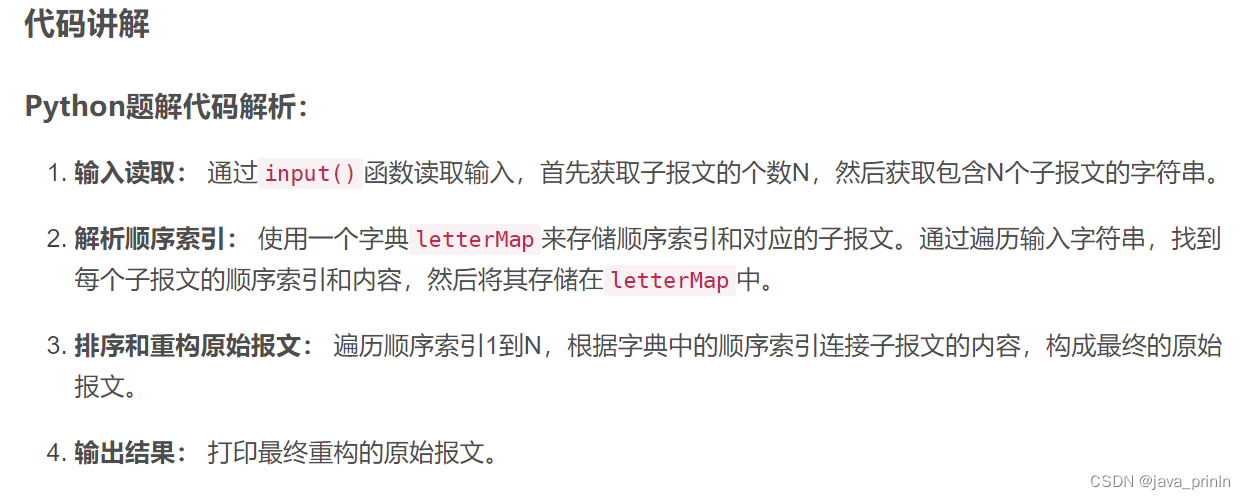
整数编码
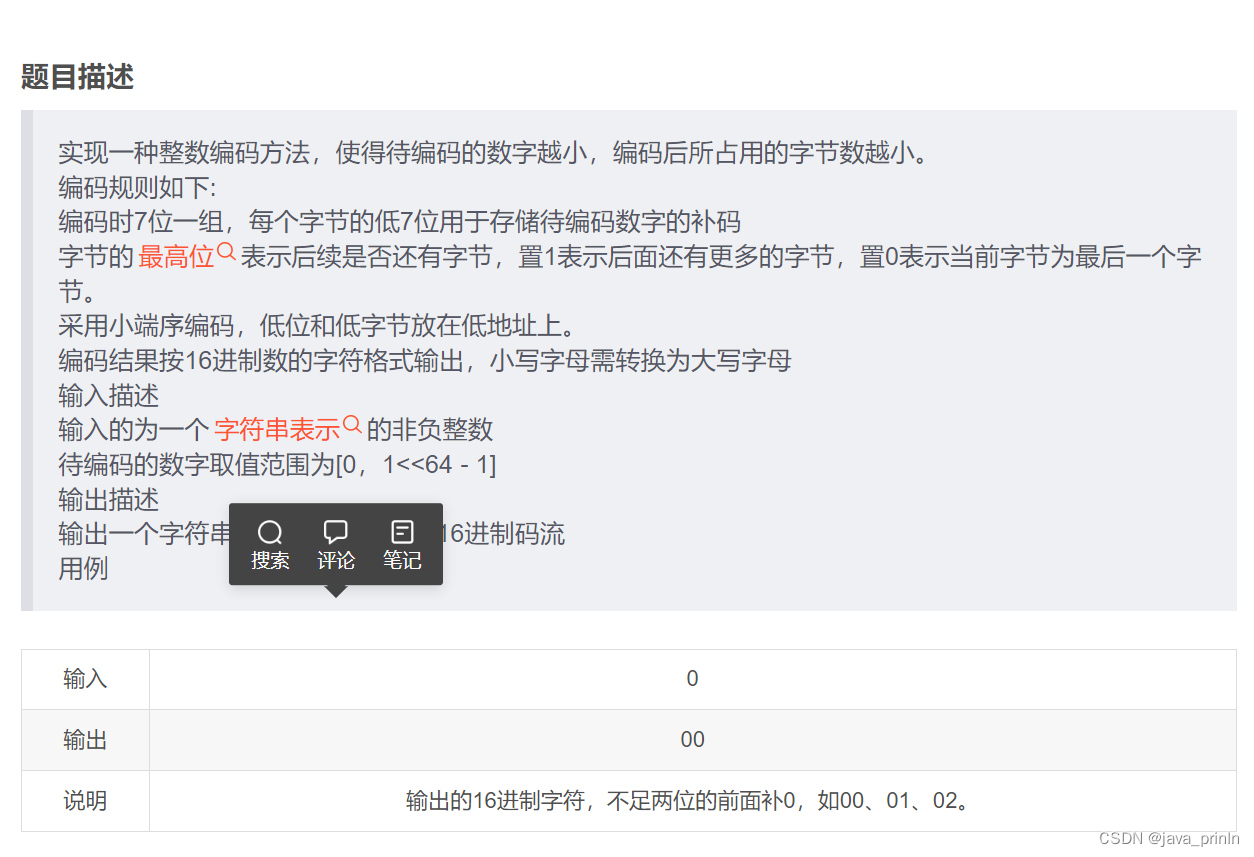
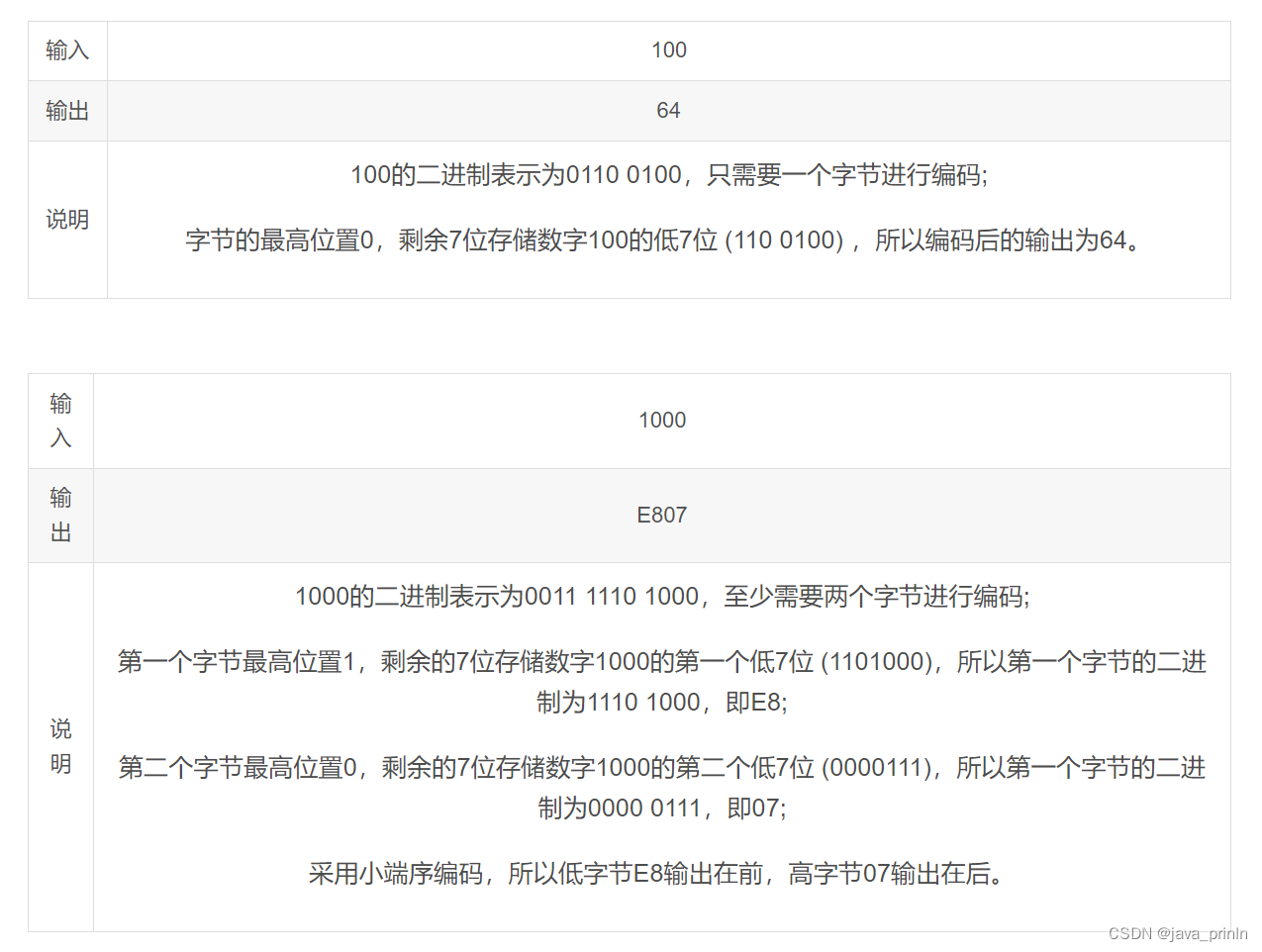
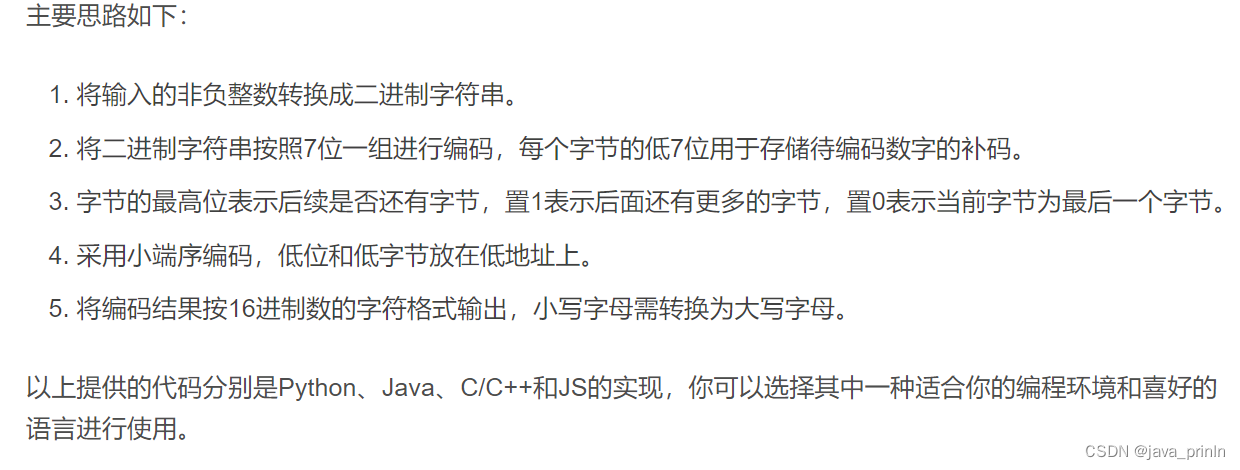
num = int(input())
# 将待编码数字转换成二进制字符串
binaryStr = bin(num)[2:]
result = ''
# 每7位一组进行编码
for end in range(len(binaryStr), 0, -7):
# 取出当前组需要编码的二进制字符串
currentBinaryStr = binaryStr[max(end - 7, 0):end]
# 判断当前字节是否为最后一个字节,设置最高位
flag = '1' if end - 7 > 0 else '0'
# 将当前字节转换成十进制数
decimal = int(flag + currentBinaryStr, 2)
# 将当前字节的十六进制字符串形式添加到结果中
hexStr = hex(decimal)[2:].upper()
# 如果十六进制字符串长度为1,需要在前面补0
hexStr = '0' + hexStr if len(hexStr) == 1 else hexStr
# 将当前字节的十六进制字符串形式添加到结果中
result += hexStr
# 返回编码结果的十六进制字符串形式
print(result)
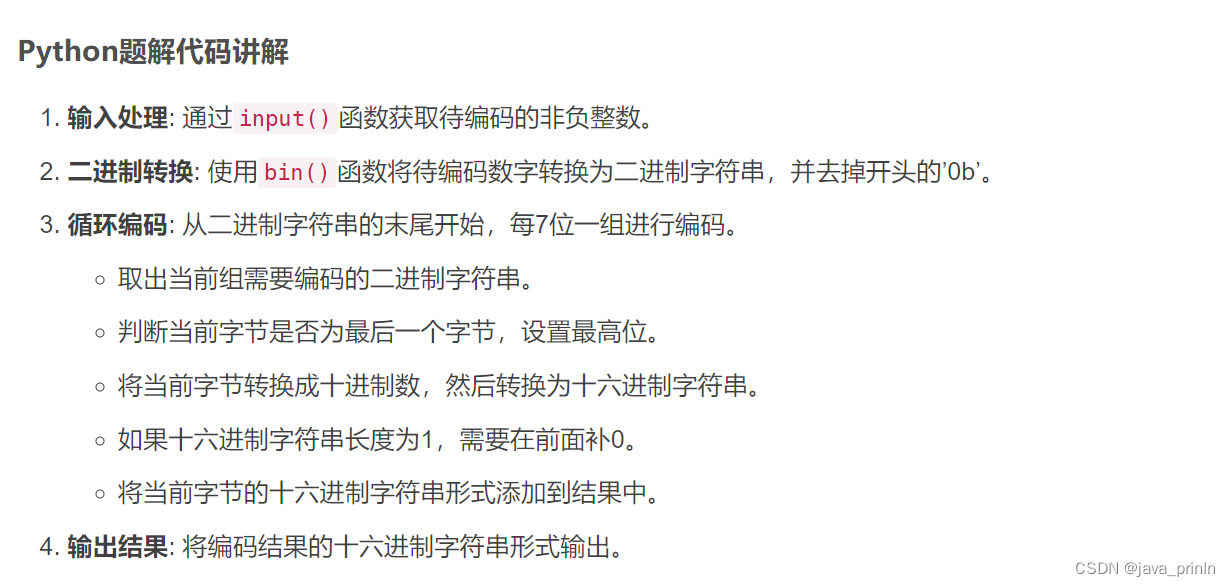

![[C/C++]string类常用接口介绍及模拟实现string类](https://img-blog.csdnimg.cn/direct/367e962274e24e46ba2abeee0f0bf148.png)
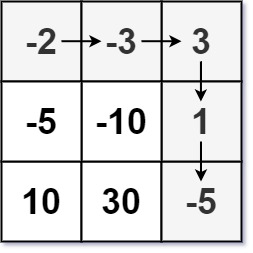


![[QT]自定义的QtabWidget](https://img-blog.csdnimg.cn/direct/52ed24c0306e4ea8a3846f376dfcb375.gif)



